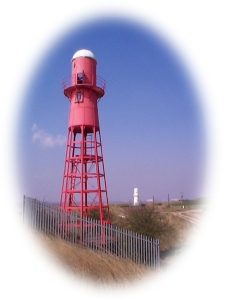|
|
|
The Lights at Thorngumbald Clough
 Thorngumbald Clough lights - the white lighthouse (the Low Light) can be seen in the distance; the red lighthouse is the "High Light" |
Paull has been in existence since at least the eleventh century and most probably much longer. A settlement more or less on the same site as the present village is recorded in the Domesday Book as "Pagula," which was the Latin term for a stake marking a landing-place. Since the land is extremely low-lying (in places below sea level) and at the time, before relatively recent drainage to provide fertile farmland, mostly marshland, the approach from the river would have been difficult and dangerous, across saltmarsh and mudflats at low tide and shallow water even at high tide. The villagers of Paull were, until recent times, dependent on the river for their livelihoods and much of their transport, so a marker visible from the seaward approaches would have been essential to ensure a safe landing. The name "Pagula" appears on old maps in various spellings and was soon contracted to "Pagul" and thence "Pagil" or "Paghil" and eventually "Paul" and "Paull." The variant Paghill is still in use today, in the area of Paull known as Paghill. |
Paull
is situated on the north bank of the Humber seven miles south-east of Hull
and is the only riverside village downstream of the city. Hull grew to be
a major port mainly because of the existence of the deep-water channel which
swings across the estuary and approaches very close to the north bank at
precisely this point; this channel is, however, narrow and hedged in with
sandbanks, so navigating it is a very precise art! Modern technology has
reduced the risks, but back in the early 19th century sailors needed help
in getting in and out of the port and lighthouses were one important method.
The lighthouses at Paull all face towards Hull and were built to aid ships
leaving the Hull docks and guide them along the deep-water channel; in 1836
Trinity House, who are responsible for all lighthouses in the British Isles,
decided to build a lighthouse at Paull as an aid to navigation from the
port of Hull : as they left Hull ships would steer for the light at Paull
and once they reached Paull they would realign towards similar lighthouses
on the south bank and follow the channel further out into the estuary and
eventually out into the North Sea. Unfortunately the sandbanks are continually
shifting and need constant dredging for them to maintain their position.
In the 19th century they didn't have the same technology as we have today
so when the channel moved place, the ships had to sail along a different
course and not towards the lighthouse at Paull. So the lighthouse in the village became obsolete and in around 1870 had to be replaced by new lights further downriver, at Thorngumbald Clough. These new lights are "leading lights" and were more sophisticated than the first lighthouse in that they had to be aligned ; when they were seen in a straight line one above the other, the ship's captain would know he was on the correct course for the deep-water channel. The old lighthouse stood derelict for several years but was eventually bought and converted into a dwelling, and subsequent alterations and extensions have turned it into a very individual and desirable home indeed! The lights at Thorngumbald Clough are still operating although there was some discussion about whether to re-site them when the sea defences were re-aligned in 2003, the keeper's cottage having been demolished in 1998. In the end the lights were left where they were, on a promontory with the flooded land circling round behind them. |
|
- Photo gallery of the Thorngumbald Clough lights -
Home Page - Introduction - Site Index - Links